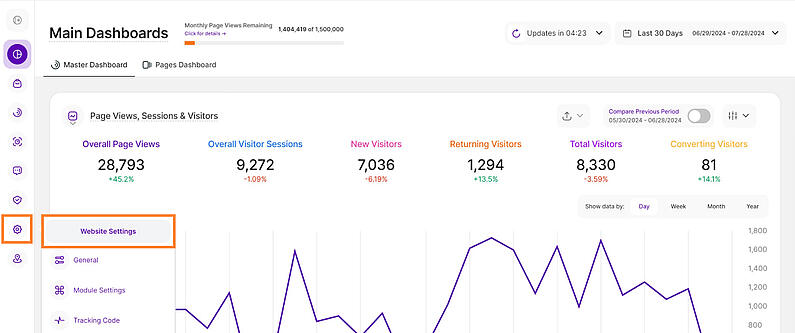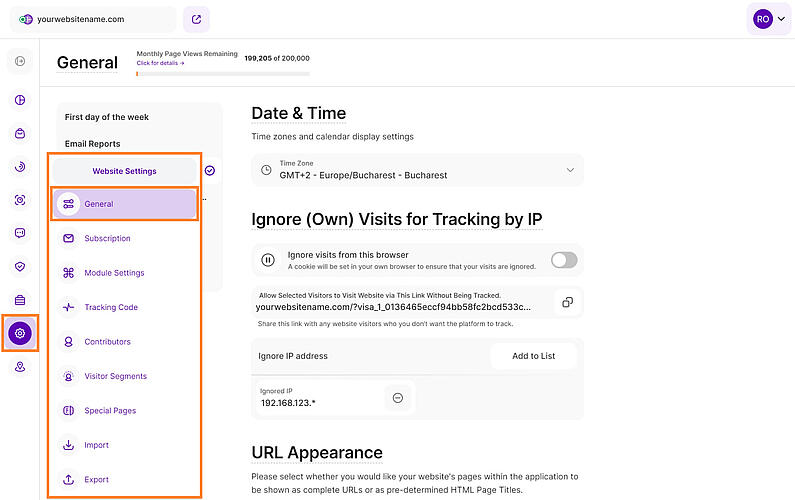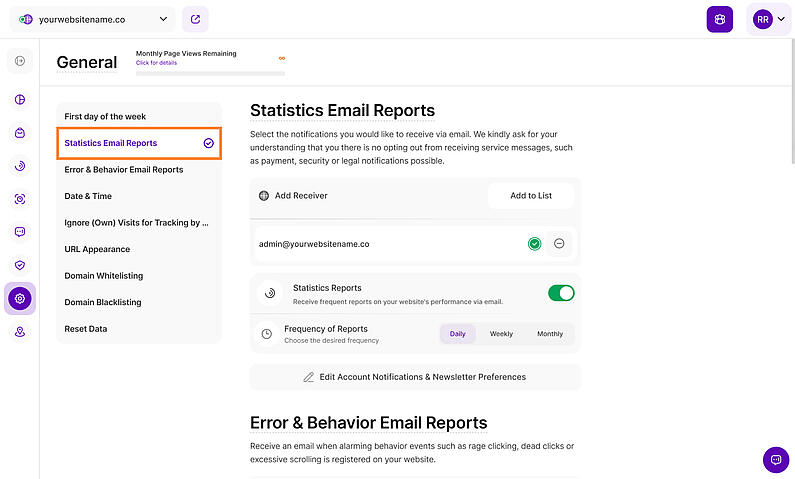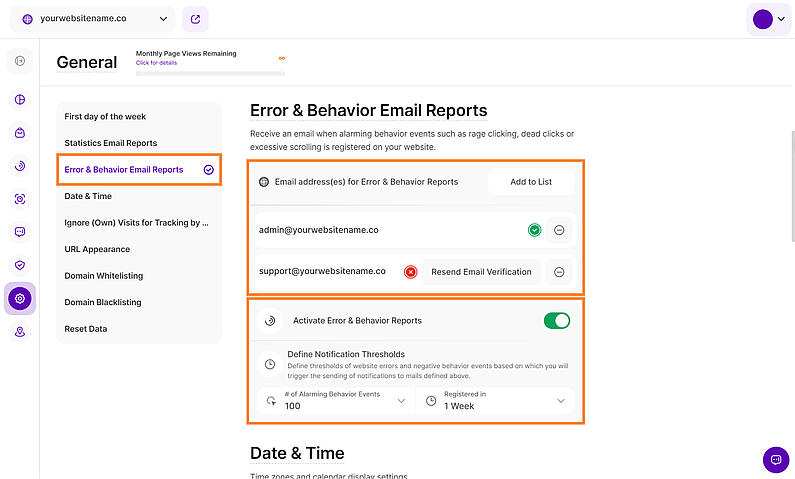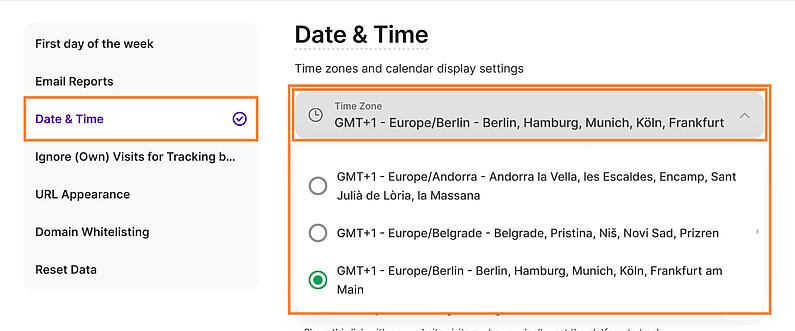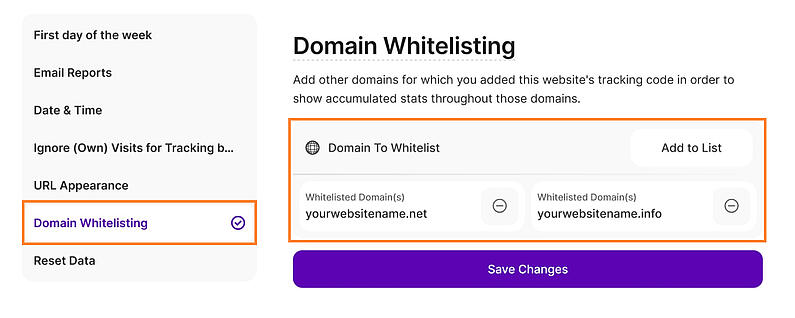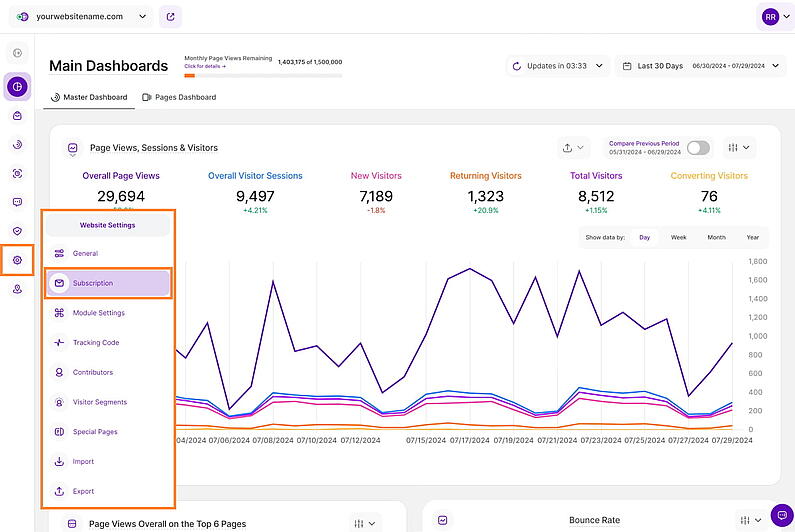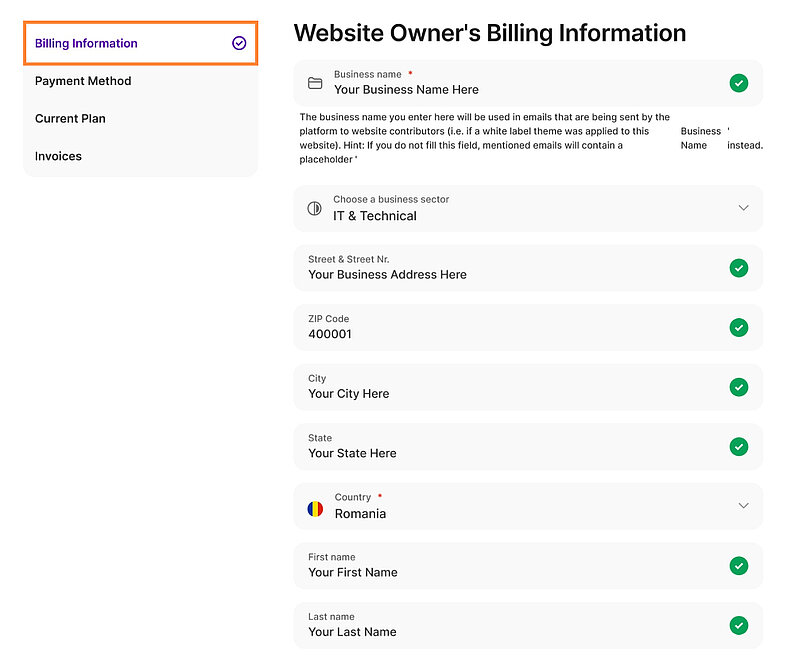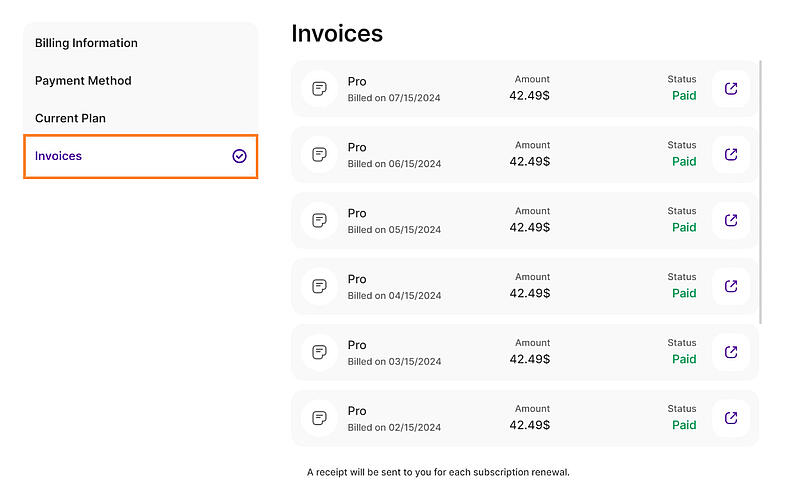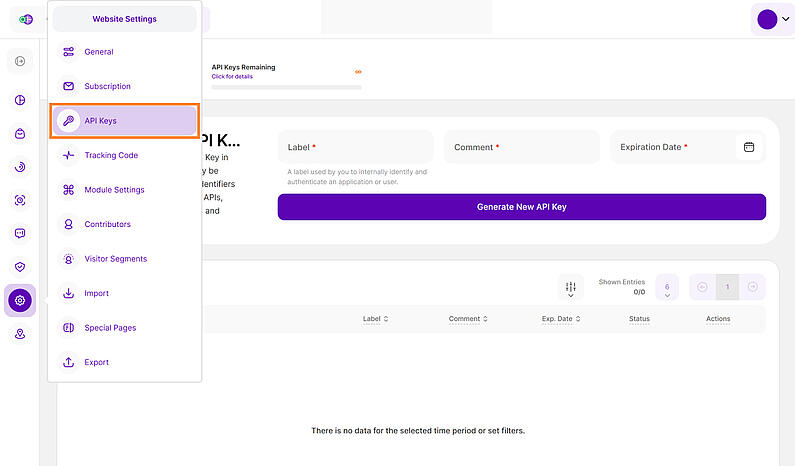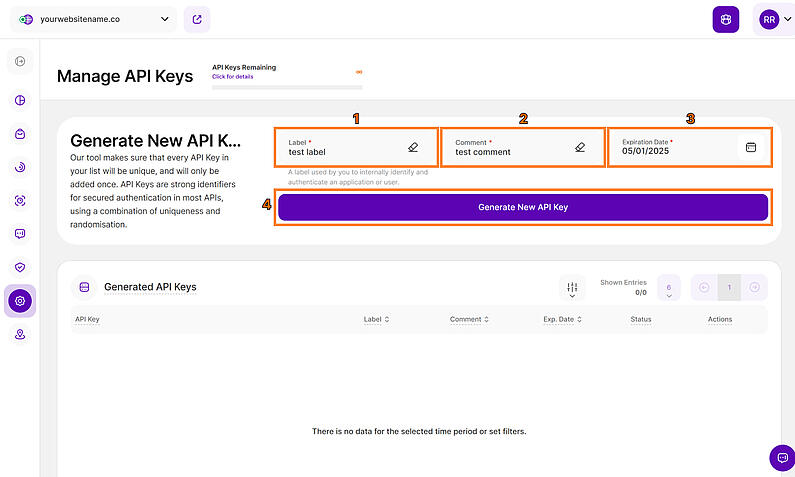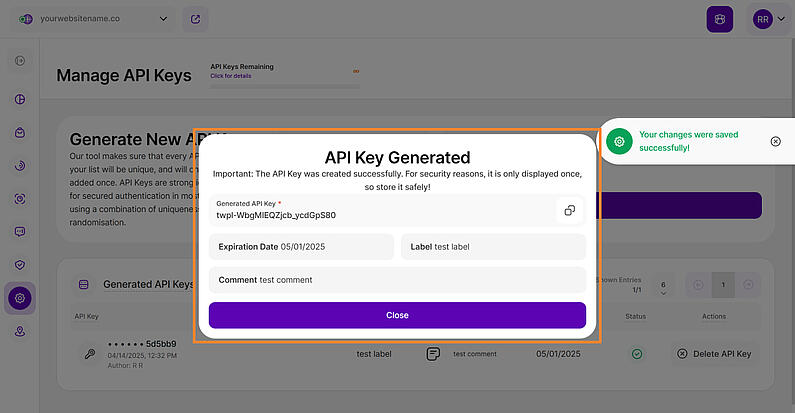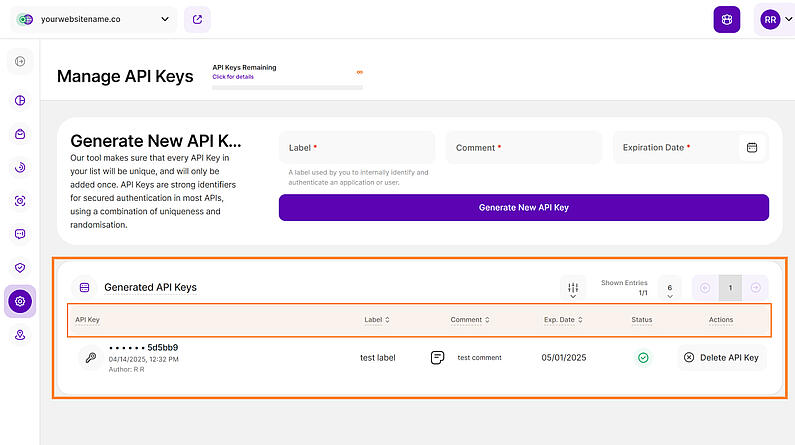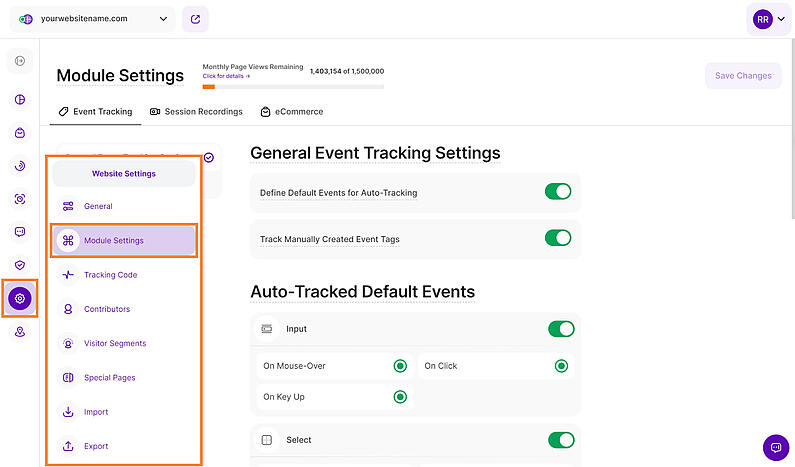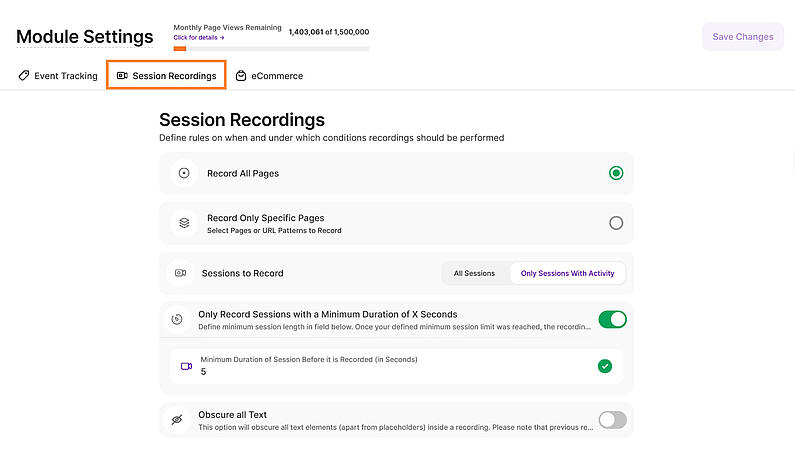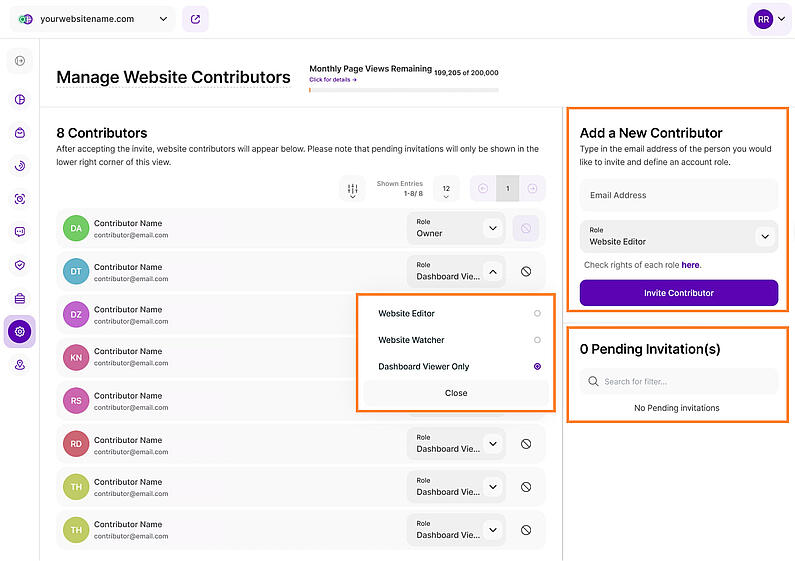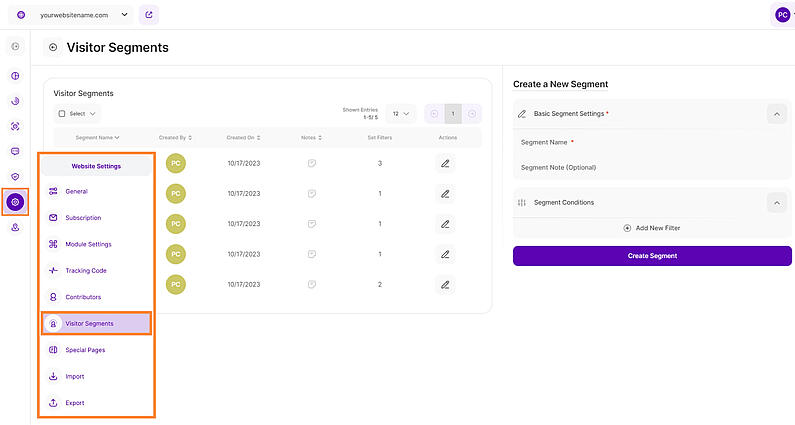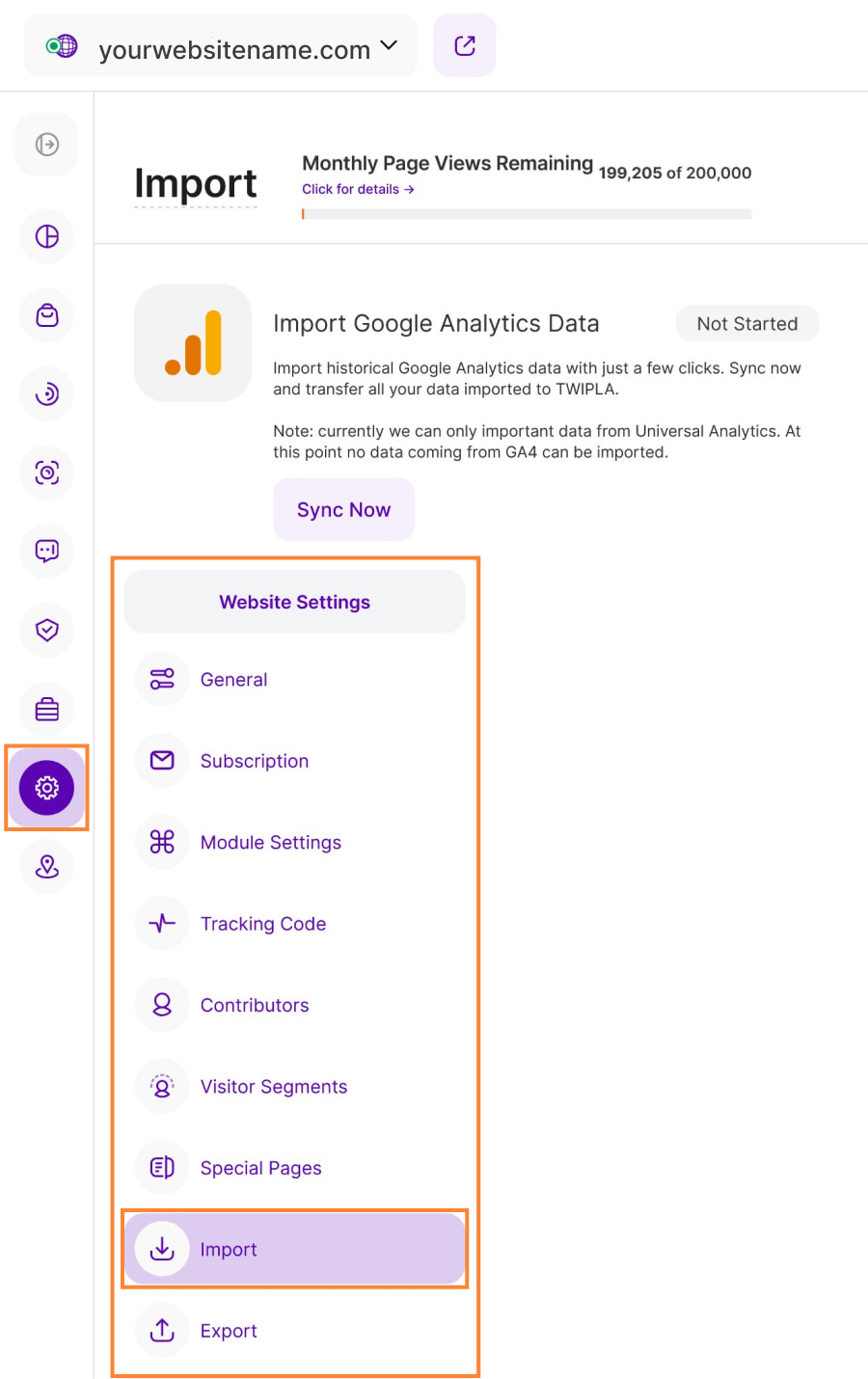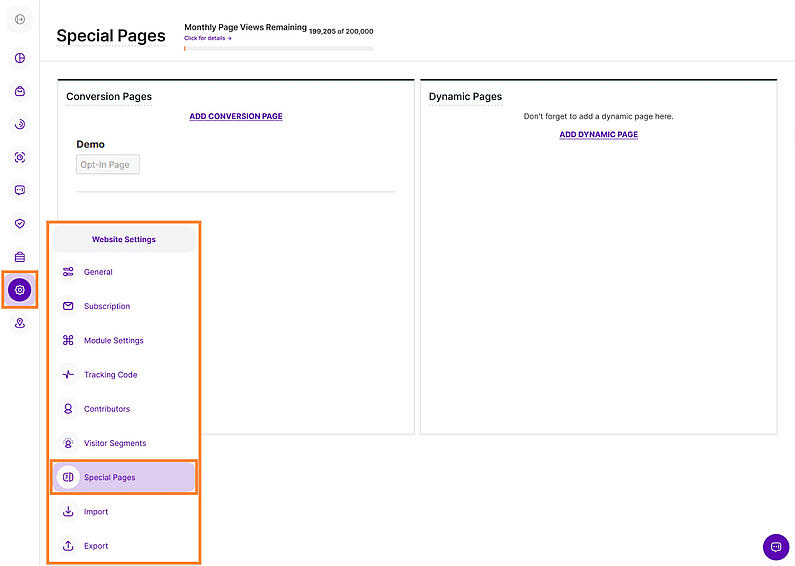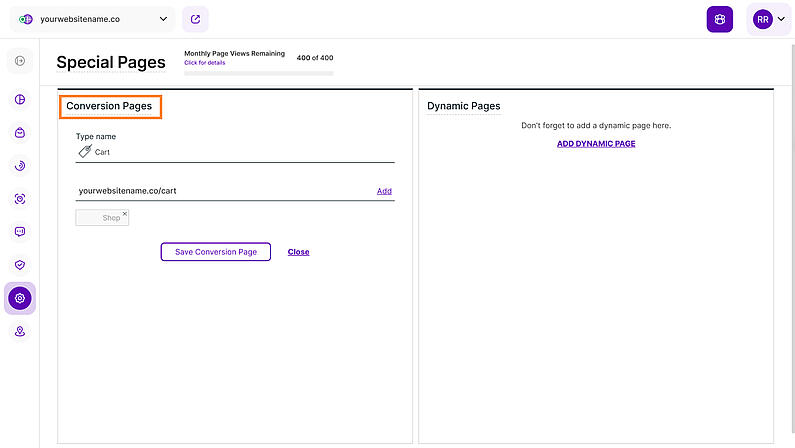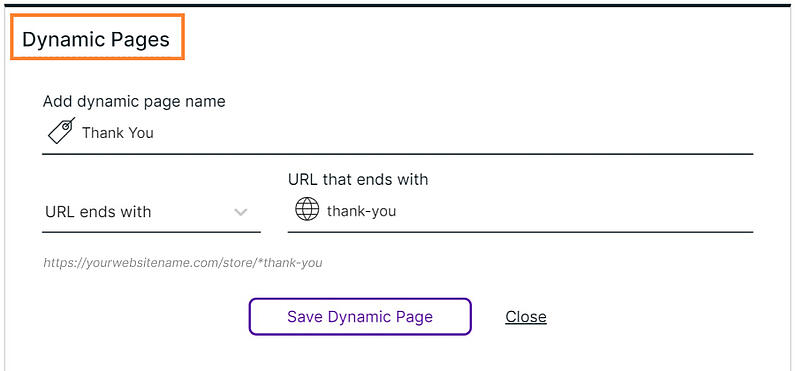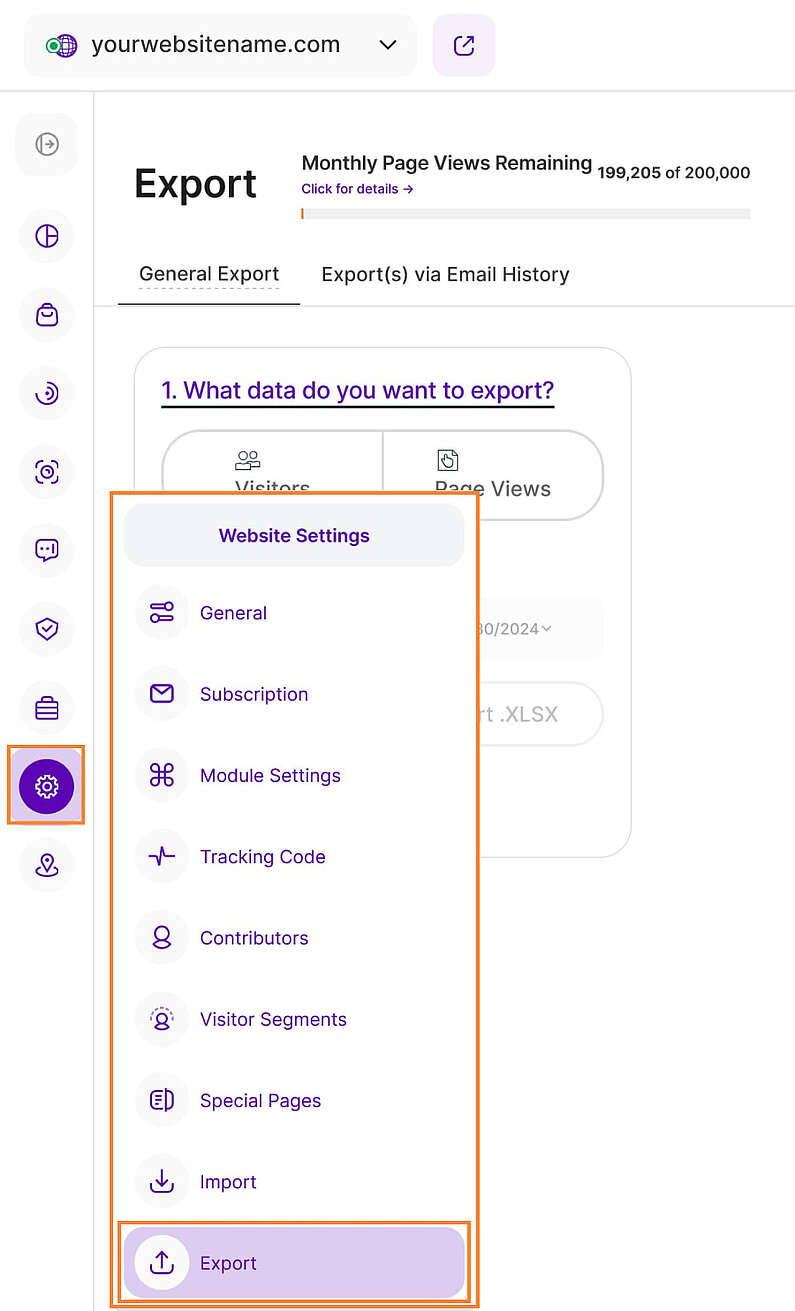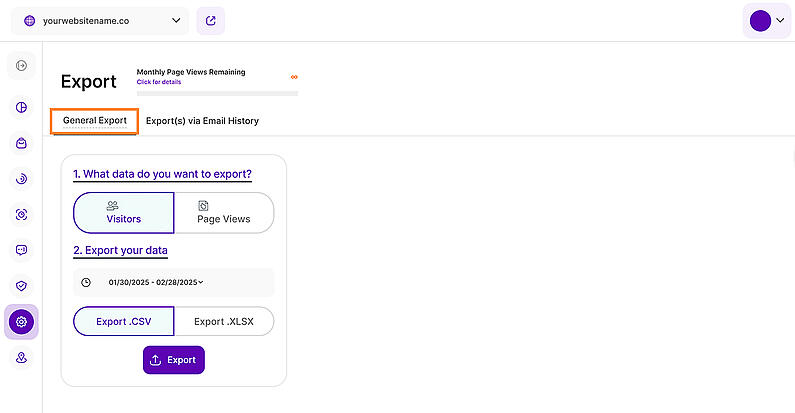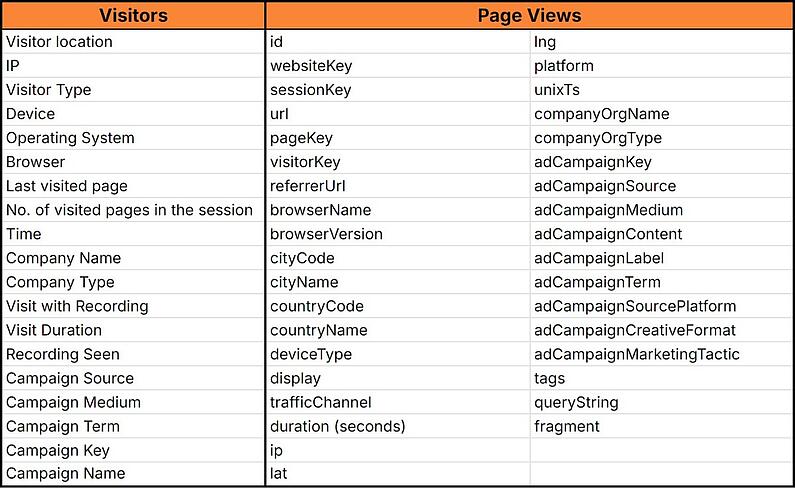- Why Us?
- Features
White Label
For SaaS Platforms & Agencies
Provide our complete analytics suite to your clients, directly within your own interface and with your/their own branding. Discover Analytics-as-a-Service and White Label Analytics. Great benefit, minimal effort.
- Pricing
- White Label
- Success Stories
- ResourcesGetting Started
-
Frequently Asked Questions
-
All About Features
- How to Install the Tracking Code
-
User Guides
-
Integrating With Other Platforms
-
Legal, Data Privacy & Certificates
- White Label Analytics
- Glossary
- Affiliate Program
- Contact
Website Settings
All You Need to Know About Your Website's Settings
In the Website Settings module, you can manage specific components of your website such as general settings, subscription, visitor segments, export and more. If you have more than one website to manage, you can switch between them using the drop-down menu in the top left corner.
Important Hint:
- If you have more than one website in your account, remember that these settings only apply to the selected website within the dropdown in the upper left corner of this view. If you want to apply a certain setting for all the websites added to your account, you need to repeat the setting for each website.
- Privacy Center has been moved to the main navigation bar. Everything about the privacy settings can be found here.
Here you will find all the important general settings, like time zone, email reports, and many more, that you can define for each website. You can update the website's settings anytime you like. These settings are available for both website owners and website contributors.
This section allows you to manage the notifications you would like to receive via email, keeping you informed about your website's performance and new content without needing to log into your account.
Delivered straight to your inbox, the Statistics Reports provide a concise summary of your website's most important metrics, such as the number of visitors, unique visitors, page conversions, and many more.
You can now add multiple email addresses as recipients for the email reports. Previously, only one email address could be added per website. Each recipient will receive an individual email.
Here’s how to manage your email reports:
- The email address that the user used as admin for this website is shown as verified by default. It displays a green check icon on the right side. Note that you can remove it and replace it with another email address.
- To add another email address, click on the textbox to enter the email address, and then click Add to List.
- The email address will be added to the list with a red x icon, indicating it’s not yet verified.
- You’ll receive a verification email to confirm the email address; once confirmed, it will show as verified with a green check icon. If you fail to receive a verification email, click the Resend Email Verification button next to the email address.
- Toggle the radio button to activate the statistical reports.
- Choose your desired frequency to receive your reports: daily, weekly, or monthly.
At the bottom of this section, you'll find the Edit Account Notifications & Newsletter Preferences button. Clicking it would redirect you to the My Account section of the Account Settings. Here, you can select which notifications you would like to receive at your account's email address.
Note: You cannot opt out of receiving service messages, such as payment, security, or legal notifications.
Set up email adddresses to which error alert reports can be sent when alarming behavior events (ABEs) are detected on your website, such as rage clicks, dead clicks, or excessive scrolling.
Here’s how to manage your Error & Behavior Email Reports:
- To add an email address, click on Email address(es) for Error & Behavior Reports on the left of the Add to List button to open the textbox.
- In the textbox, type the email address, and then click Add to List.
- The email address will be added to the list with a red x icon, indicating it’s not yet verified.
- A verification email will be sent to the address you provided. Click the link in the email to complete the verification process. Once verified, a green checkmark will appear next to the email address.
- If you don't receive a verification email, click Resend Email Verification next to the email address. If you want to remove the email address, simply click the '-' icon.
Note: This feature is disabled by default. To enable notifications, toggle the Activate Error & Behavior Reports switch.
Control the frequency of email alerts by setting the notification thresholds based on your preference. An email report is sent only when the specified number of events occurs within the chosen timeframe.
- # of Alarming Behavior Events: Specify the number of alarming behavior events (from 1 to 100,000) that must occur.
- Registered in: Choose the period over which these events are counted (from 1 hour to 4 weeks).
Example: If you set the event threshold to 100 and the timeframe to 1 hour, you will receive an email report if 100 or more unusual behavior events are detected within a single hour.
By proactively monitoring these events, you can identify usability issues and improve user experience.
To suit a wide range of users, the list of available time zones has been expanded. This update includes both US and international cities, providing a comprehensive selection to ensure precise configuration.
Setting your website's time zone is a straightforward process. You can choose any of the following options to set up your time zone:
- Dropdown Selection: Use the dropdown list to select your time zone. The list is extensive, so you should be able to find your city or the closest alternative easily.
- Text Search Box: If you prefer, you can also use the text search box to quickly locate your city. Simply start typing the name of your city, and the search box will filter the options accordingly.
Note: If you have multiple websites, remember to set the time zone for each newly added domain.
Want to exclude your own visits from your data? With this setting you can ignore your own visits by IP or by setting a browser cookie!
Choose from these options:
- Ignore visits from this browser: If you choose to use the "ignore" function for your own views of your website, the application will not count any of this data. Visits from other people using the same browser (but who have a different IP address), will still be tracked. Note: A cookie will be set in your own browser to ensure that your visits are ignored.
- Allow Selected Visitors to Visit Website via This Link Without Being Tracked: Unsure of your team's IP addresses or simply want to exclude specific visits? Share the unique link displayed in this section with them. Visiting your website through this link will automatically prevent their activity from impacting your data analysis.
- Ignore IP Address or Range: Ignore visits from a specific IP address or range. After you enter the IP address, click Add to List and Save Changes to apply the settings.
You can customize how your website's URLs are displayed. Choose whether to display your website pages within the app as complete URLs or, as before, as predetermined html page titles – based on the text in the page URL.
Select the option that best suits your needs:
- Show Page Title & URL: This provides a clear and descriptive view of each page, including both the title and the full URL. It enhances user experience by giving visitors a quick understanding of the page's content.
- Show Only Entire URL: This option displays only the full URL for each page. While it ensures you always see the complete address, it may appear less user-friendly as it lacks descriptive context.
Domain Whitelisting lets you include your website's tracking code on related domains and subdomains, ensuring comprehensive visitor data.
For instance, if your website is "mywebsite.com", you can whitelist your tracking code for mywebsite.shopify.com and track all the visits under a single instance. You can also add rules to whitelist all subdomains for a specific domain in a similar manner: *.anotherwebsite.com.
How To Implement Cross-Domain Tracking
Our cross-domain tracking lets you see website traffic from all your domains and subdomains within a single account and site. This provides a consolidated view of your audience and website performance across your entire online presence all in one place!
Setting Up Cross-Domain Tracking:
- Log in to your account and select the website you want to enable cross-domain tracking for.
- Navigate to Website Settings > General.
- Scroll down to the Domain Whitelisting section.
- Click Domain To Whitelist.
- Enter the domain or subdomain you want to track.
- Click Add to List.
- Repeat for any additional domains or subdomains you want to track.
- Once finished, click Save Changes to confirm.
- Navigate to Website Settings > Tracking Code.
- Locate the tracking code for your website and click Copy Snippet to Clipboard button to copy the code.
- Access the source code of each subdomain you whitelisted and paste the copied tracking code into the appropriate location within the source code of each subdomain.
Now you're all set! Our app will now track visits from your whitelisted domains and subdomains, providing you with a unified view of your website traffic.
Note: You can view the statistics of the whitelisted domains under the Pages Dashboards.
This option allows website owners to permanently erase all tracking data associated with this website within our application. The action, which can only be performed by a website owner, will remove all your statistics from your account. Your preferences will be kept the same as before. You will have to confirm this action by entering your password.
If you prefer to receive the deleted data via email for backup purposes, we will first send you a link with your "website statistics archive" and only then reset data. Please do not forget to activate the corresponding checkbox in the modal which appears after clicking the "Reset Data" button. These processes might take up to 24h – based on your website traffic.
Important Hint: While the reset is in progress, your statistics will not be tracked!
This section empowers you to manage all aspects of your website's billing conveniently. You can enter your billing information, manage your payment method, choose the perfect pricing plan based on your website traffic and view your invoices.
The information you add will be used and shown on the automatically generated billing statements for this website.
You can add or edit the following information:
- Business name (required)
- Business sector
- Street & Street Nr.
- ZIP Code
- City
- State
- Country (required)
- First name
- Last name
Once you've finished updating your information, simply click "Save Changes" at the upper right corner. Feel free to edit it anytime!
Important Note: Changes to your billing information will only be reflected on invoices generated after you save the updates.
In this section, you can add or change your payment method. Currently, we can only accept PayPal or credit card payments.
You can also turn off the auto-renewal here.
Important Notes:
- If you have a Wix website, the entire billing will be done via Wix. Unfortunately, we cannot provide the information. Please check directly with WiX or log in to your Wix account.
- If you updated your payment method, it will only be displayed here after your next billing cycle.
This section provides you with the information, on which pricing plan you are currently on – based on your website's traffic. The more traffic your website has, the higher your success. However also our cost increases in processing your data.
You can start with the "FREE forever" plan that makes it easy for you to test drive, with zero commitment and pay as you grow.
Unlock more features! Upgrade your plan by tapping the "+" or "Change plan" button.
Here, you can view a list of the invoices generated for the selected website that you can view and save as a PDF for future use.
The list displays the following information:
- Name of the Plan
- Billed date
- Amount
- Status
Simply click the open new tab icon to view the invoice.
Alternatively, you can view the invoices for all your websites by going to Account Settings > Invoices.
Important Note: These invoices only refer to "non-Wix websites". The billing for Wix websites is done separately on WiX.
The user is now able to use generated API keys instead of unsecure username/password combinations to securely and efficiently integrate with third-party APIs that require authentication. Without a mechanism for users to provide their own API keys, the app would face limitations in offering customizable integrations or would need to rely on shared or hardcoded credentials, which could lead to security vulnerabilities or scalability issues.
Within this submodule, you'll find two sections:
Our platform makes sure that every API Key in your list will be unique, is only shown once at point of generation and NOT saved within our databases. API Keys are strong identifiers for secured authentication in most APIs, using a combination of uniqueness and randomization.
To generate a new API key:
- Enter a Label: This label helps you internally identify and authenticate an application or user.
- Add a Comment: Add any comment or context for this key.
- Set the Expiration Date: Choose the date when this key should automatically expire.
- Click the Generate New API Key button.
Important Note: The number of possible API keys to be generated per website depends on the website’s pricing plan.
Upon successful generation, a pop-up window will display "API Key Generated." You will also see a confirmation message, "Your changes were saved successfully," appear on the right side of the screen. Hint: For security reasons, generated API Keys are only shown fully right after their generation. You can copy the key and store it safely.
This report block features a table view visualization showing all generated API Keys. The table includes the following columns:
- API Key: An API key allows you authenticated communication between our platform and third-party applications without having to share your user data. You can also see the date, time and creator.
- Label: A label manually defined by the API key creator when generating the API key to better identify an API key.
- Comment: A comment added manually by you when generating the API key to make it easier to understand the assignment later on.
- Exp. Date: The expiration date of the validity of the API key that you defined manually when generating the API key.
- Status: Here you see whether an API key is currently active or has already expried.
- Actions: All available actions for each API key. Here, you'll find the option to delete the API Key.
To refine your data, filter by Comment, Label, or Status. Save your current filter selections as a template by clicking "Save set filter combination as a template” on the right. To begin a new filter or to just remove the applied one, click "Remove All filters."
Additionally, you can configure the number of entries shown per page and utilize the pagination feature to navigate the data.
In this section, you can manage your website’s tracking code. The tracking code is a unique JavaScript snippet assigned to each website you add to your account. Whether during the onboarding process or at a later stage, you have the flexibility to install the tracking code according to your preferences. The installation process may vary depending on the platform or website builder you are utilizing.
On the left side of this module, you'll find your Website ID, along with convenient shortcuts: Install Snippet Guide, Contact Our Support, and Book Online Now. This allows you to easily locate the Website ID, which can be used for installations through various methods, such as Google Tag Manager.
We provide two installation options, enabling you to select the one that best fits your requirements:
- Manual Code Installation
For those who prefer hands-on control, manually installing the tracking code is straightforward. Simply copy the unique code generated for your website and embed it into your site's source code, ideally just before the closing </body> tag.
- Install as Native Platform Plugin Without Snippet
Alternatively, our app can be installed as a plugin or extension on various popular website builder platforms. This eliminates the need for manual code insertion. Simply select your platform from the list provided and get our app directly from the corresponding app markets:
To ensure compliance with data privacy regulations while enhancing data collection, we've updated our tracking code. Now, you have access to two tracking codes generated for your selected website:
We recommend this approach when running our app entirely in Maximum Privacy mode (see Privacy Center > Maximum Privacy) on a cookie banner-free site. For website visitors from countries where you have calibrated our app to a less strict privacy mode, data collection is limited to visitors who accept the website cookie banner.
This setup enables the platform to collect GDPR and ePrivacy-compliant data fundament around session numbers and triggered website events.
This scenario can also be used for websites with a cookie consent banner that regulates data collection when the app is set to a lower data privacy mode for any visitor country location (something that can be calibrated in the Privacy Center). However, data is only collected from website visitors who opted in. Website visitors (the session and any of the visitor’s linked actions/event triggers) that opted out will be completely lost to your data set.
Option 2: Visitor Consent Needed (Data Privacy not set to Maximum Privacy Mode)
We recommend this approach for websites with cookie banners and with our app running below Maximum Privacy Mode for any visitor location (so “Light”, “Medium”, or “GDPR” Privacy Mode). It enables you to collect privacy-perfect data on ALL website visitors, regardless of consent preferences. This is the right tracking code scenario if you have a cookie banner and don’t run our app in Maximum Privacy Mode for all visitor countries of origin (something that can be calibrated in the Privacy Center).
Similar to the Default Tracking Code(first option), it enables our app to collect data from visitors who accept the cookie banner in line with the privacy level set for their location.
For website visitors who reject non-essential technical cookies, this snippet will automatically recalibrate data capture to Maximum Privacy Mode. Our app will then collect a core dataset on all website visitors who opted out - providing you with session numbers and triggered events. So regardless of their cookie choices, no core data is lost.
Important Notes:
- Always ONLY load one snippet at the same time. Avoid situations in which you add a tracking code generically to your HTML + again load it via a cookie management platform or the like.
- If a website visitor chooses to neither opt-in nor opt-out then no snippet is loaded and no sessions or events are captured.
This section of the Module Settings allows you to select which type of event you want to be tracked by our platform: manually created event tags, default events being auto-tracked or both.
Once accessed, you will have two types of settings available:
- General Event Tracking Settings: This setting allows you to enable or disable the following options:
- Define Default Events for Auto-Tracking - enable/disable only the tracking of automatically identified events
- Track Manually Created Event Tags - enable/disable only the tracking of manually added events
- Auto-Tracked Default Events: This setting shows you what elements (Input, Select, TextArea, Button, RadioButton, Checkbox) on the site could be automatically identified with the current version, and the actions (On Mouse-Over, On Click, On Key Up, On Change) that can be tracked for each element.
Important Notes:
- This feature acts 100% complementary to any manual event tags, so without the need to add any manually created tag snippets to your source code. Just turn the Auto-Tracking ON to get it started.
- For Wix websites, only Auto-Tracking is possible (at least for the moment), so there will be no option to track manually created event tags.
- The Labels of the elements, are automatically procured from your HTML page, so directly from the code, as they were called when the site was built. If you want the label of a tracked element to have a different name, that needs to be changed within the HTML of the page directly.
Both the Category and the Action labels of these auto-tracked elements are standard (as per the list presented above) and cannot be edited. - Elements that are part of a pop-up, or something dynamic that appear on your page as a result of certain actions taken by the user, they may not be properly treated by our system (e.g., Hovering an image of a product that will make a "Buy now" button to appear, might be one of the cases when we cannot track fired events on that newly appeared element, since it's not something static that was on the page from the beginning).
- Very soon, we will also add other elements for which these fired events can be tracked, such as images, links, videos etc. for the next version(s).
This section allows you to define how you want to set the recordings based on your preference. These configurations pertain exclusively to the "Session Recordings" module and do not impact your website or account settings in any way.
Essentially, there are five aspects that can be customized within this module:
- Record All Pages: This activates the feature to capture sessions for every visitor navigating any page on your website. Once this option is chosen, no further customization choices will be available. In essence, it implies that every interaction by visitors on your website will be documented, with the recording influenced by the conditions you've defined for individual visitor sessions.
- Record Only Specific Pages: Once this option is selected, only visits to your defined pages within your website will be recorded. Two further options are available to you:
- Select Page From Website: Select a page from the autogenerated suggestion list or search for a URL by typing parts of the URL into the field. Note: Please make sure that all “/” are placed correctly in the URL. Otherwise, you may experience problems with the tracking of visitors.
- Select Custom URL Pattern: Select one of the options in the drop-down list to define which rule should be utilized for this funnel level to count visits.
- Sessions to Record: This allows you to choose between recording all sessions or only those with activity.
- Only record sessions with a minimum duration of X seconds. It allows you to define the minimum session length. If you don’t want those quick visits to be recorded, then this option would work best for you. Once selected, another option will appear below:
- Minimum Duration Recording (in Seconds): Simply type in the duration (in seconds) in the text field.
- Obscure all Text: This feature provides an option to obscure all text elements within a recording, enhancing privacy and data security. When activated, this option will automatically obscure any text that appears in the recordings, except for placeholder text. This means that any sensitive information entered by users, such as names, email addresses, or other personal data, will not be visible in the recordings.
- Previous recordings will not be affected by this option, only recordings created after activation.
- All existing websites have the toggle disabled. You can enable it by switching the radio button.
- If the toggle is ON all newly created recordings have their text replaced with random letters.
Important Note: If you update your settings for the session recordings module in any way, you always have to click on the button "Save Changes" at the top right of this view.
This section allows you to manage the default currency for your eCommerce statistics. Currently, you can choose from three available currencies:
- EUR (Euro)
- USD (US Dollar)
- RON (Romanian Leu)
Note: You can change the default currency at any time to match the currency used for your eCommerce website.
This submodule allows you to manage your website contributors with ease. This view is divided into three sections.
On the left, you'll find the first section which shows the list of the contributors. To modify the current contributors (only possible as an owner), you need to click the dropdown list and select another contributor role.
At this point, the application differentiates between four contributor roles:
- Owner: Someone who can access all available settings for a website (even reset its data, delete it, etc.). You are an owner if you are the person that added the website to your account and invited others.
- Website Editor: A person that was added to "contribute" to a specific website. This role can edit most of the settings for the website, but cannot reset or delete it.
- Website Watcher: This contributor type has "read only" permissions - they can see all information, but are completely restricted when it comes to changing anything.
- Dashboard Viewer Only: This user can only view the exact data that the admin is filtering or segmenting for. Dashboard viewers do NOT have the ability to update the dashboard's data nor can they click on links taking them to other features inside the platform.
On the right side is the second section, Add a New Contributor. To add a new contributor to your website:
- Type in the email address of the person you would like to invite.
- Define an account role from the dropdown menu.
- Click the Invite Contributor button.
The last section shows the Pending Invitations. The email addresses of the contributors you invited will be listed here.
If the invited Contributor already has an account in our app, they just need to accept the Contributor role, and the website data will be displayed in their account. If the Contributor is not registered, they should first register to be able to accept the Contributor role.
For more details on managing your website contributors, you can read more here.
Note: You can use the filter option to search for the Contributor Name or Email.
Visitor Segments is a powerful feature that allows users to tailor their analytics and gain insights into specific groups of website visitors. This enables you to categorize visitors based on various attributes, making it easier to analyze their behavior and preferences.
The Visitor Segments page is divided into two main parts:
- Existing Visitor Segments Table: This part displays a list of visitor segments that have already been created.
- Create a New Segment: This area allows you to create new visitor segments.
Important Note: Access to this feature requires the purchase of a minimum pricing plan. If you do not have the required plan, you will be prompted to upgrade when attempting to create a new segment.
Everything about the corresponding functionality of this module and much more can be found here.
You can now seamlessly integrate your existing Universal Google Analytics (UGA) data with our app!
We strongly recommend that you import your data after successfully installing our app on your website and having at least one visit tracked by our app to ensure continuity.
As the data is imported, you may see it in real-time. We'll import your data chronologically, starting with the most recent information, giving you a clear picture of your website's historical performance.
More details can be found here.
Important Note: You can only import the data once per website!
With this feature you can define for which page of your website that your visitors visit, you would like to see a conversion in your statistics within the application. You can also group single pages to one conversion page in order to see cumulated statistics. This will allow you to better evaluate the actual success of guiding your visitors through your core processes (i.e. set a conversion when a visitor has completed the checkout on your homepage, has subscribed to your newsletter, has registered as a website-member, etc.). Conversion pages can only be defined by yourself. Until you have done so, no numbers of conversions will be shown.
If you want to add a new conversion page for the selected website, please click on ADD CONVERSION PAGE. A new modal will open for which you have to fill out the fields. Try this functionality and analyze your results, there is nothing that can go wrong and your visitors will not notice anything.
Important Hints: You can see the statistics of your self-defined conversion pages in the Page Views, Sessions & Visitors Dashboard (Main Report Block) as Converting Visitors or you can go to Pages --> Conversion Pages.
In this view you can group identical pages with different URLs (i.e. the same product page for different articles) of your website for clustered statistics.
Imagine you have an E-commerce website. There is a high chance that you will have the same "Thank you" page for all product purchases at the end of the checkout (even though this page has different dynamic parameters in its URL, based on the purchase). If you do not cluster these URLs, you will see data on each "Thank you" page even though it is the same. Clustering these URLs allows you to see combined statistics for this page, but it will not change your data.
If you want to add a new dynamic page for the selected website, please click on ADD DYNAMIC PAGE. A new modal will open for which you have to fill out the fields. Try this functionality and analyze your results, there is nothing that can go wrong and your visitors will not notice anything.
Say goodbye to data limitations! Our revamped Export feature empowers you to effortlessly export even the most extensive datasets for your website including company names, UTM Campaigns, and more. Gain deeper understanding and unlock actionable insights with a breeze.
This view is divided into two tabs:
Important Note: Great news! We've removed the 31-day limit, giving you the flexibility to analyze your data for any timeframe you need.
This section allows you to download specific data from the website you've chosen. Explore your options and tailor your export to your needs with these easy steps:
- Choose Your Data: Select whether you want to export Visitors data or Page Views (formerly "Visits") history, depending on your specific needs.
- Visitors (19 columns): This dataset focuses on details related to individual visitors.
- Page Views (36 columns): This dataset captures detailed information about each page view.
- Set the Time Frame: Refine your export to a specific time range, whether it's the past day, week, month, or a custom date range. This allows you to focus on the data that matters most for your current analysis. Hint: The FREE plan limits your data history view and download to the most recent 40 days.
- Pick Your Format: Download your data in either CSV or XLSX format, compatible with popular spreadsheet and analysis tools. Choose the format that would best suit your workflow and preferences.
- Click and Export: It's that simple! With just a few clicks, you can now have a comprehensive file ready for in-depth exploration and analysis. Once an export is ready, only the user who requested the export will be notified via email.
The visibility of specific information is restricted based on your data privacy settings, contribution role, and subscription plan.
If you are subscribed to the minimum pricing plan that includes the Company Reveal feature, you will also see the Company names where the IP Address is registered to and the Company Type would be listed as Banking, Business, etc. Otherwise, it will only display the ISP/Carrier Network name with the Company Type listed as isp. You can read more about the Company Reveal feature here.
The following information are exclusively accessible to the website owner or editor: Company Name, Company Type, Visit with Recording, Visit Duration, Recording Seen, Campaign Source, Campaign Medium, Campaign Term, Campaign Key, Campaign Name, Pages Count and Session Duration. Check here about the contribution roles.
This new tab under the Export view displays the history of the requested exports (sent via email) for the past 7 days.
The table is consists of the following columns:
- Type of Export: Shows either Visitors or Pages based on the type of data that you have exported.
- Time Period: The specific date range covered in the exported data set.
- Status: The current status of your export, either "In Progress" or "Completed".
- Progress: Shows the percentage of completion for ongoing and completed exports.
- Requested At: The date and time the export request was submitted.
- Completed At: (Appears only for completed exports) The date and time the export was finished.
- File Format: The format you chose for the exported data, either csv or xlsx.
- File Size: The size of the downloaded file.
- Action: Shows two options - Download File or Cancel export.




